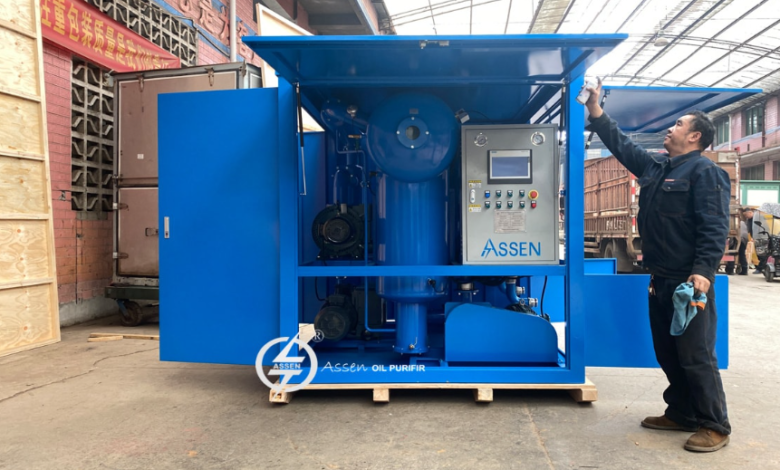High vacuum oil purifier overview

Introduction
Oil plays a crucial role in many industrial and electrical applications, particularly in transformers, turbines, and hydraulic systems. Over time, oil can become contaminated with moisture, gases, and solid particles, which degrade its quality and performance. A high vacuum oil purifier is an advanced machine designed to clean and restore oil by efficiently removing these impurities. This article explores the features, working principle, advantages, and applications of a high vacuum oil purifier.
What is a high vacuum oil purifier?
A high vacuum oil purifier is equipment that uses vacuum technology to purify oil by extracting moisture, dissolved gases, and solid contaminants. The high vacuum environment lowers the boiling points of water and gases, enabling their removal at relatively low temperatures, which helps maintain the oil’s chemical and physical properties. The purifier typically combines vacuum dehydration, degassing, and multi-stage filtration to deliver clean and dry oil suitable for reuse.
Why use a high vacuum oil purifier?
Oil contamination causes several problems:
- Moisture lowers oil insulation and can cause corrosion.
- Dissolved gases reduce dielectric strength and indicate possible faults.
- Solid particles cause abrasion and clogging in systems.
Using a high vacuum oil purifier helps address these issues by:
- Removing moisture and gases effectively.
- Filtering out solid impurities.
- Extending oil and equipment life.
- Reducing maintenance costs and downtime.
Components of a high vacuum oil purifier
Typical components include:
- Heating system: Warms the oil to reduce viscosity and improve impurity removal.
- Vacuum chamber: Creates a low-pressure environment for evaporation of moisture and gases.
- Filtration units: Multi-stage filters capture solid particles and sludge.
- Pump assembly: Circulates oil through the purifier continuously.
- Control panel: Monitors temperature, vacuum level, and operational parameters.
How does a high vacuum oil purifier work?
The purification process involves several steps:
- Oil is heated to a temperature around 70-80°C to reduce its viscosity.
- The heated oil enters the vacuum chamber where the high vacuum reduces pressure, causing moisture and dissolved gases to evaporate at low temperatures.
- Evaporated water and gases are extracted from the chamber.
- Oil passes through filters that remove solid contaminants.
- Degassing further removes residual dissolved gases to restore oil purity.
This process is repeated continuously until the oil meets the required quality standards.
Applications of high vacuum oil purifiers
High vacuum oil purifiers are used in:
- Power plants to maintain transformer and turbine oils.
- Electrical substations for transformer oil purification.
- Hydraulic systems in heavy machinery.
- Industrial plants requiring clean lubrication oil.
- Oil recycling and servicing companies.
Their ability to provide clean, dry oil is crucial across many industries.
See also: What to Look for When Buying an Internet Business
Advantages of high vacuum oil purifiers
improved oil quality
Effective removal of moisture, gases, and solids restores oil dielectric and lubrication properties.
cost efficiency
Purifying and recycling oil reduces the need for new oil purchases and expensive equipment repairs.
environmental protection
Reusing oil lowers hazardous waste generation and supports sustainable operations.
enhanced safety
Removing contaminants reduces the risk of electrical faults and mechanical failures.
Maintenance tips for high vacuum oil purifiers
For optimal operation:
- Regularly replace filters to prevent clogging.
- Monitor vacuum pressure, temperature, and pump functions.
- Inspect and maintain seals, hoses, and valves to prevent leaks.
- Clean heating elements and vacuum chambers periodically.
- Schedule professional servicing for calibration and troubleshooting.
Proper upkeep ensures long-term purifier efficiency and reliability.
Technological innovations
Modern high vacuum oil purifiers feature:
- Automated control with real-time monitoring and alarms.
- Energy-saving designs for reduced power consumption.
- Portable models for on-site purification.
- Advanced filtration materials for better contaminant capture.
- IoT integration for predictive maintenance and data analysis.
These enhancements improve user experience and purification results.
Selecting the right high vacuum oil purifier
Consider the following factors:
- Volume and type of oil to be purified.
- Level of contamination and purification requirements.
- Desired degree of automation and ease of use.
- Space availability and portability needs.
- Budget and after-sales service.
Choosing an appropriate purifier guarantees effective and economical oil treatment.
Conclusion
A high vacuum oil purifier is vital for maintaining high vacuum oil purifier reliability in various industries. By efficiently removing moisture, gases, and solid contaminants, it extends oil and machinery life, reduces operational costs, and supports environmental sustainability. Integrating a high vacuum oil purifier into regular maintenance practices ensures safer, more efficient, and cost-effective operations.





